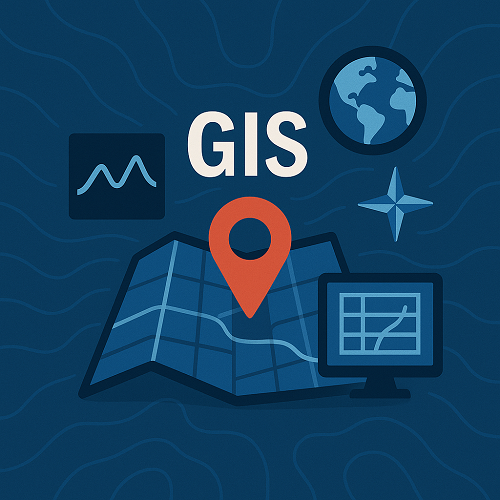- GIS market growth is accelerating in 2025, especially in healthcare, insurance, and infrastructure planning.
- Esri is launching new AI-enhanced tools and forming strategic partnerships to push GIS capabilities further.
- Artificial Intelligence integration in GIS is improving predictive analytics and spatial decision-making.
- Businesses are leveraging GIS for risk assessment, resource allocation, and customer location intelligence.
- Real-world case studies show measurable ROI from GIS adoption in both public and private sectors.
What’s new right now
The Geospatial Information System (GIS) industry is seeing rapid transformation in early 2025. According to recent reports, the GIS market is expanding at double-digit growth rates, led by adoption in sectors like healthcare for epidemic tracking and in insurance for precise risk modeling. Esri continues to innovate, releasing AI-powered analytics tools and deepening collaborations with cloud providers and data platforms. AI integration is no longer experimental; companies are embedding machine learning directly into geospatial workflows to enable faster, more accurate insights (source).
Why it matters
For business leaders, these advancements mean better decision-making tools, quicker risk evaluation, and the ability to unlock location-based opportunities. For technical stakeholders, new AI-GIS integrations promise reduced manual data preparation, advanced spatial pattern detection, and scalable deployment via cloud GIS platforms.
Industries such as urban planning, retail, logistics, energy, and environmental management are already benefiting from these innovations, creating competitive advantage for early adopters.
Key trends shaping GIS technology in 2025
1. AI-driven spatial analytics
From predictive disease spread models to customer catchment analysis, AI models are now running directly on spatial databases, reducing data handling overhead and providing real-time insight streams.
2. Industry-specific GIS solutions
Vendors are creating tailored GIS applications for healthcare diagnostics, insurance claims mapping, and agricultural yield forecasting, ensuring domain-specific data models are part of the product at launch.
3. Integration with IoT and live data feeds
Connected devices are constantly producing georeferenced data. Modern GIS platforms are integrating with IoT data pipelines to provide live maps and dashboards for monitoring assets or environmental conditions.
4. Cloud-native GIS deployments
Cloud-based GIS solutions are enabling teams across geographies to collaborate seamlessly on large-scale datasets without heavy local hardware requirements.
Comparing GIS approaches
| Approach | Strengths | Limitations |
|---|---|---|
| Traditional Desktop GIS | Powerful analysis tools, offline capability | High hardware demands, limited collaboration |
| Cloud GIS | Scalable, collaborative, hardware-light | Dependent on internet connectivity |
| AI-Integrated GIS | Automated insights, fast decision support | Requires quality datasets and skilled model tuning |
| Industry-Specific GIS Apps | Prebuilt workflows, targeted analytics | Less flexibility for cross-domain projects |
Mini case study
Problem: A regional health authority needed to predict hospital bed demand during seasonal flu outbreaks, but lacked real-time, location-specific forecasting capability.
Approach: They implemented an Esri-based GIS platform integrated with AI models that consumed live patient admission data, weather patterns, and demographic information. Data was visualized on interactive maps that updated daily.
Outcome: The authority improved resource allocation efficiency by 18%, reduced emergency overflow events by 12%, and enhanced stakeholder confidence through transparent reporting.
Implementation checklist
- Define clear business objectives for GIS adoption (e.g., risk analysis, customer mapping).
- Audit existing spatial and non-spatial datasets for quality and coverage.
- Select a GIS platform aligned with your scalability and integration needs.
- Incorporate AI and automation for faster, more accurate analysis.
- Train staff on both the technical and strategic use of GIS tools.
- Pilot the solution in a controlled environment before full-scale deployment.
- Continuously monitor performance and update datasets to maintain accuracy.
FAQs
1. What is driving the GIS market growth in 2025?
Growing adoption in healthcare, insurance, and infrastructure planning, plus AI integration, are major drivers.
2. How is AI impacting GIS workflows?
AI enables faster insights, automates pattern detection, and reduces manual data preparation.
3. Which industries benefit most from GIS right now?
Healthcare, insurance, logistics, urban planning, and environmental monitoring are leading adopters.
4. Are cloud GIS solutions secure?
Yes, when using reputable providers with strong encryption, access controls, and compliance adherence.
5. Can small businesses use GIS effectively?
Absolutely. Cloud-based and subscription GIS tools make entry affordable for smaller organizations.
6. How soon can we see ROI?
Many projects see measurable ROI within 6-12 months, depending on scope and integration depth.
Conclusion
GIS technology in 2025 is more powerful, accessible, and essential than ever before. The confluence of AI, cloud computing, and industry-specific tools is unlocking new possibilities for insight and efficiency. Organizations ready to harness these advances will be positioned to outpace their competition. To learn how you can integrate cutting-edge GIS solutions into your operations, explore our GIS services today.
